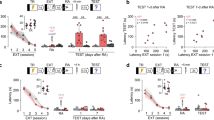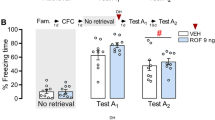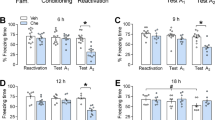Abstract
We examined whether protein kinase M zeta (PKMζ) inhibition in the amygdala permanently disrupts fear memory by testing retention at various intervals after PKMζ blockade. Although the expression of fear memory was disrupted when the inhibitor was applied shortly before testing, it had no effect when rats were tested with longer retention intervals. These results suggest that PKMζ inhibition does not erase memory, but temporarily disrupts expression of memory.
This is a preview of subscription content, access via your institution
Access options
Subscribe to this journal
Receive 12 print issues and online access
$209.00 per year
only $17.42 per issue
Buy this article
- Purchase on Springer Link
- Instant access to full article PDF
Prices may be subject to local taxes which are calculated during checkout



Similar content being viewed by others
Change history
15 August 2011
In the version of this article initially published, the numbers of rats reported in the legend of Figure 3a were transposed with those in the legend of Figure 3b. The correct values are (a) ZIP, n = 6; SCR ZIP, n=8; and (b) ZIP and SCR ZIP, n = 7 each. In all cases, the correct numbers were used for the analyses, so the statistics reported remain accurate. The error has been corrected in the HTML and PDF versions of the article.
References
Sacktor, T.C. et al. Proc. Natl. Acad. Sci. USA 90, 8342–8346 (1993).
Ling, D.S. et al. Nat. Neurosci. 5, 295–296 (2002).
Pastalkova, E. et al. Science 313, 1141–1144 (2006).
Shema, R., Sacktor, T.C. & Dudai, Y. Science 317, 951–953 (2007).
Serrano, P. et al. PLoS Biol. 6, 2698–2706 (2008).
Migues, P.V. et al. Nat. Neurosci. 13, 630–634 (2010).
Estes, W.K. Psychol. Rev. 104, 148–169 (1997).
Stafford, J.M. & Lattal, K.M. Learn. Mem. 16, 494–503 (2009).
Jones, S.V., Heldt, S.A., Davis, M. & Ressler, K.J. Behav. Neurosci. 119, 329–335 (2005).
Paschall, G.Y. & Davis, M. Behav. Neurosci. 116, 4–12 (2002).
Kwapis, J.L., Jarome, T.J., Lonergan, M.E. & Helmstetter, F.J. Behav. Neurosci. 123, 844–850 (2009).
Sossin, W.S. Trends Neurosci. 31, 170–175 (2008).
Gale, G.D. et al. J. Neurosci. 24, 3810–3815 (2004).
Sacco, T. & Sacchetti, B. Science 329, 649–656 (2010).
Acknowledgements
We thank G. Gafford for comments on the manuscript. This research was supported by grants R37 MH047840 (to M.D.) and F32 MH090700 (to R.G.P.) from the US National Institutes of Health. Support was also provided by the Center for Behavioral Neuroscience (National Science Foundation agreement IBN-987675) and by an US National Institutes of Health/National Center for Research Resources base grant (P51RR000165) to Yerkes National Primate Research Center.
Author information
Authors and Affiliations
Contributions
R.G.P. designed and carried out the experiments, analyzed the results, wrote the initial manuscript and was involved in the revisions. M.D. was involved in the experimental design, helped interpret the data and contributed to writing and revising the manuscript.
Corresponding author
Ethics declarations
Competing interests
The authors declare no competing financial interests.
Supplementary information
Supplementary Text and Figures
Supplementary Figures 1–3 and Supplementary Methods (PDF 136 kb)
Rights and permissions
About this article
Cite this article
Parsons, R., Davis, M. Temporary disruption of fear-potentiated startle following PKMζ inhibition in the amygdala. Nat Neurosci 14, 295–296 (2011). https://doi.org/10.1038/nn.2745
Received:
Accepted:
Published:
Issue Date:
DOI: https://doi.org/10.1038/nn.2745
This article is cited by
-
Role of prelimbic cortex PKC and PKMζ in fear memory reconsolidation and persistence following reactivation
Scientific Reports (2020)
-
Zeta Inhibitory Peptide attenuates learning and memory by inducing NO-mediated downregulation of AMPA receptors
Nature Communications (2020)
-
GSK-3β activation is required for ZIP-induced disruption of learned fear
Scientific Reports (2020)
-
Conditioned stimulus presentations alter anxiety level in fear-conditioned mice
Molecular Brain (2019)
-
Involvement of Protein Kinase Mζ in the Maintenance of Long-Term Memory for Taste Aversion Learning in Young Chicks
Bulletin of Experimental Biology and Medicine (2015)



